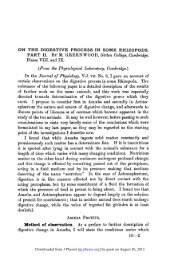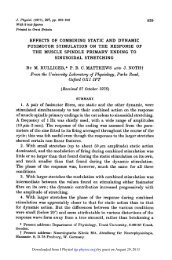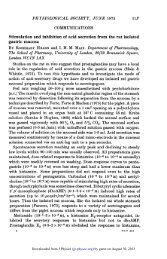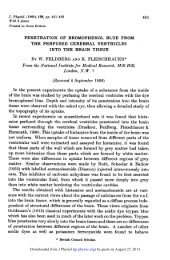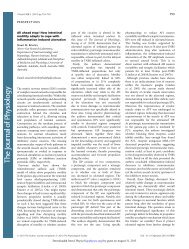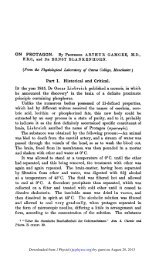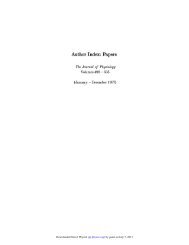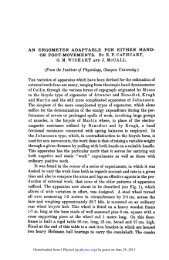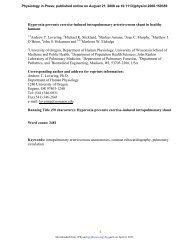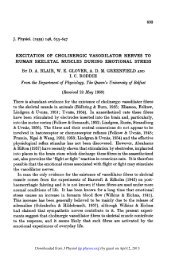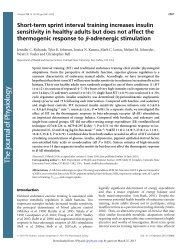The efficiency of contraction in rabbit skeletal muscle fibres ...
The efficiency of contraction in rabbit skeletal muscle fibres ...
The efficiency of contraction in rabbit skeletal muscle fibres ...
Create successful ePaper yourself
Turn your PDF publications into a flip-book with our unique Google optimized e-Paper software.
J. Physiol. 517.3 Efficiency <strong>of</strong> <strong>muscle</strong> <strong>contraction</strong><br />
853<br />
<strong>in</strong> rat fast <strong>muscle</strong> <strong>fibres</strong> (9·6 W l¢; Reggiani et al. 1997) or<br />
<strong>in</strong> human type IIB <strong>fibres</strong> (3·5 W l¢; Bott<strong>in</strong>elli et al. 1996).<br />
Potma & Stienen (1996) measured •20 W l¢ at a<br />
shorten<strong>in</strong>g velocity <strong>of</strong> 1 ML s¢ and 15 °C, although these<br />
authors did not show that this is maximal because no data<br />
were obta<strong>in</strong>ed for higher shorten<strong>in</strong>g velocities. <strong>The</strong> high<br />
power output obta<strong>in</strong>ed here results from the relatively l<strong>in</strong>ear<br />
force—velocity relationship: at <strong>in</strong>termediate shorten<strong>in</strong>g<br />
velocities, force is 2—3 times higher than <strong>in</strong> other studies.<br />
Maximal power output is temperature and species<br />
dependent so that the variations <strong>in</strong> power output<br />
measurements found <strong>in</strong> the literature are not surpris<strong>in</strong>g. For<br />
example, Ranatunga (1998) found that at 35 °C, power<br />
output <strong>of</strong> fast <strong>muscle</strong> <strong>fibres</strong> <strong>of</strong> the rat was 250 W l¢,<br />
dropp<strong>in</strong>g to less than 13 W l¢ at 10 °C, with a QÔÑ <strong>in</strong> the<br />
5—7 range below 20 °C.<br />
<strong>The</strong> <strong>efficiency</strong> <strong>of</strong> <strong>contraction</strong> obta<strong>in</strong>ed here reached 0·36<br />
(<strong>in</strong>terpolation <strong>in</strong> Fig. 9). As power output is more<br />
temperature sensitive than the ATPase (Ranatunga, 1998),<br />
it is expected that the <strong>efficiency</strong> will <strong>in</strong>crease with<br />
<strong>in</strong>creas<strong>in</strong>g temperature. In this calculation, the energy<br />
<strong>in</strong>put <strong>in</strong>cludes the ATP hydrolysed to ma<strong>in</strong>ta<strong>in</strong> the<br />
isometric state. <strong>The</strong> relationship between <strong>efficiency</strong> and<br />
speed <strong>of</strong> <strong>contraction</strong> is very similar to that obta<strong>in</strong>ed <strong>in</strong><br />
<strong>in</strong>tact frog <strong>muscle</strong> shorten<strong>in</strong>g at 0 °C (Fig. 4.38A <strong>in</strong> Woledge<br />
et al. 1985), even though the ATP cleavage <strong>in</strong> frog <strong>muscle</strong><br />
<strong>in</strong>cludes that required for pump<strong>in</strong>g calcium <strong>in</strong>to the<br />
sarcoplasmic reticulum. Potma & Stienen (1996) obta<strong>in</strong>ed a<br />
value <strong>of</strong> 0·25, but these authors did not <strong>in</strong>vestigate<br />
shorten<strong>in</strong>g at velocities higher than 1 ML s¢. Reggiani et al.<br />
(1997) reported a value <strong>of</strong> 0·28. <strong>The</strong> experimental conditions<br />
differ ma<strong>in</strong>ly <strong>in</strong> the animal used (<strong>rabbit</strong> vs. rat) and <strong>in</strong> the<br />
concentration <strong>of</strong> Pé <strong>in</strong> the solution. In our work the Pé<br />
concentration was very low (< 1 ìÒ) because <strong>of</strong> its b<strong>in</strong>d<strong>in</strong>g<br />
to MDCC-PBP, whereas <strong>in</strong> the work <strong>of</strong> Reggiani et al. and<br />
<strong>of</strong> Potma & Stienen, it would have been <strong>in</strong> the millimolar<br />
range. Power output and ATPase activity dur<strong>in</strong>g shorten<strong>in</strong>g<br />
have been shown to be modulated by free Pé concentration<br />
(Potma & Stienen, 1996). <strong>The</strong>se authors found that <strong>in</strong> <strong>rabbit</strong><br />
psoas <strong>muscle</strong> <strong>fibres</strong> at 15 °C, the power output and ATP<br />
turnover rate decreased at low shorten<strong>in</strong>g velocities when<br />
30 mÒ Pé was added to the solutions. <strong>The</strong> high force at<br />
shorten<strong>in</strong>g velocities where power output is maximal is<br />
accompanied by a high ATPase rate so that the ratio <strong>of</strong><br />
power output to energy consumed rema<strong>in</strong>s close to that<br />
found elsewhere. <strong>The</strong> slightly higher <strong>efficiency</strong> (0·4) reported<br />
by He et al. (1998a) is a consequence <strong>of</strong> the passive,<br />
restor<strong>in</strong>g force encountered for <strong>muscle</strong> <strong>fibres</strong> shorten<strong>in</strong>g<br />
from an <strong>in</strong>itial sarcomere length <strong>of</strong> 3·0 ìm.<br />
Step size, duty ratio and myos<strong>in</strong> head <strong>in</strong>teraction<br />
distance with act<strong>in</strong><br />
<strong>The</strong> maximum ATPase rate <strong>of</strong> 18·5 s¢ at 12 °C is comparable<br />
to that obta<strong>in</strong>ed by Ma & Taylor (1994) <strong>in</strong> shorten<strong>in</strong>g<br />
my<strong>of</strong>ibrils <strong>of</strong> <strong>rabbit</strong> psoas <strong>muscle</strong> at 20 °C (22 s¢), but faster<br />
than their value at 10 °C (6·5 s¢). <strong>The</strong> direct measurement<br />
<strong>of</strong> the ATPase <strong>in</strong> shorten<strong>in</strong>g <strong>muscle</strong> <strong>fibres</strong> obta<strong>in</strong>ed here can<br />
Downloaded from J Physiol (<br />
jp.physoc.org)<br />
by guest on March 5, 2013<br />
be used to estimate the distance travelled by myos<strong>in</strong> heads<br />
for each ATP hydrolysed. At Vmax, assum<strong>in</strong>g that all<br />
myos<strong>in</strong> heads <strong>in</strong> the overlap region are active, namely<br />
participat<strong>in</strong>g equally <strong>in</strong> the hydrolysis, the distance<br />
travelled per ATP for each sarcomere, d, isgivenbyd = VÏk<br />
where V is the shorten<strong>in</strong>g velocity (<strong>in</strong> nm s¢) and k is the<br />
maximum myos<strong>in</strong> head cycl<strong>in</strong>g rate (18·5 s¢). For<br />
Vmax = 1·21 ML s¢ at 12°C and a sarcomere length <strong>of</strong><br />
2·7 ìm, each half-sarcomere shortens at 1633 nm s¢, giv<strong>in</strong>g<br />
a myos<strong>in</strong> head travel distance <strong>of</strong> 88·3 nm per ATP<br />
(1633Ï18·5). For a step size <strong>of</strong> 9 nm (mid-range <strong>of</strong> Goldman<br />
& A. F. Huxley, 1994), myos<strong>in</strong> heads may only rema<strong>in</strong><br />
attached to act<strong>in</strong> for 10 % <strong>of</strong> their cycle time (9Ï88·3) (cf.<br />
duty cycle ratio <strong>of</strong> 0·2; Ma & Taylor, 1994). This number is<br />
<strong>in</strong> agreement with stiffness measurements (Ford et al. 1985),<br />
X-ray diffraction data (Yagi & Takemori, 1995) and k<strong>in</strong>etic<br />
measurements (Brenner, 1988; Ma & Taylor, 1994), which<br />
suggest that, dur<strong>in</strong>g shorten<strong>in</strong>g, the fraction <strong>of</strong> attached<br />
myos<strong>in</strong> heads at any one time is low. <strong>The</strong> ATPase rate is<br />
seen to <strong>in</strong>crease cont<strong>in</strong>uously with shorten<strong>in</strong>g velocity<br />
(Fig. 8), even though the number <strong>of</strong> attached myos<strong>in</strong> heads<br />
is decreas<strong>in</strong>g. If shorten<strong>in</strong>g reduces the number <strong>of</strong><br />
participat<strong>in</strong>g myos<strong>in</strong> heads, the ATPase activity <strong>of</strong> the<br />
active fraction is proportionally greater. It is more likely<br />
that all myos<strong>in</strong> heads participate <strong>in</strong> shorten<strong>in</strong>g, and that<br />
the rate limit<strong>in</strong>g step <strong>in</strong> the ATPase dur<strong>in</strong>g shorten<strong>in</strong>g is<br />
the hydrolysis step which occurs while the myos<strong>in</strong> heads are<br />
detached from the th<strong>in</strong> filament. In the isometric state, the<br />
rate limit<strong>in</strong>g step is the release <strong>of</strong> hydrolysis products (ADP<br />
or Pé), with rate constants which may depend on the stra<strong>in</strong><br />
experienced by the myos<strong>in</strong> heads (Homsher et al. 1997).<br />
<strong>The</strong> calculations made here are based on the results <strong>of</strong><br />
simultaneous measurements <strong>of</strong> sarcomere shorten<strong>in</strong>g<br />
velocity, force, power output and ATPase rate <strong>in</strong> contract<strong>in</strong>g<br />
<strong>muscle</strong> <strong>fibres</strong>. <strong>The</strong>se values provide a consistent data set for<br />
calculat<strong>in</strong>g the energetics <strong>of</strong> <strong>contraction</strong> and to test our<br />
understand<strong>in</strong>g <strong>of</strong> energy transduction <strong>in</strong> <strong>muscle</strong>.<br />
Bershitsky, S., Tsaturyan, A., Bershitskaya, O., Mashanov, G.,<br />
Brown, P., Webb, M. & Ferenczi, M. A. (1996). Mechanical and<br />
structural properties underly<strong>in</strong>g <strong>contraction</strong> <strong>of</strong> <strong>skeletal</strong> <strong>muscle</strong> fibers<br />
after partial EDC cross-l<strong>in</strong>k<strong>in</strong>g. Biophysical Journal 71,<br />
1462—1474.<br />
Bl<strong>in</strong>ks, J. R. (1965). Influence <strong>of</strong> osmotic strength on cross-section<br />
and volume <strong>of</strong> isolated s<strong>in</strong>gle <strong>muscle</strong> <strong>fibres</strong>. Journal <strong>of</strong> Physiology<br />
177, 42—57.<br />
Bott<strong>in</strong>elli, R., Canepari, M., Pellegr<strong>in</strong>o, M. A. & Reggiani, C.<br />
(1996). Force—velocity properties <strong>of</strong> human <strong>skeletal</strong> <strong>muscle</strong> <strong>fibres</strong>:<br />
myos<strong>in</strong> heavy cha<strong>in</strong> is<strong>of</strong>orm and temperature dependence. Journal<br />
<strong>of</strong> Physiology 495, 573—586.<br />
Brenner, B. (1988). Effect <strong>of</strong> Ca¥ on cross-bridge turnover k<strong>in</strong>etics<br />
<strong>in</strong> sk<strong>in</strong>ned s<strong>in</strong>gle <strong>rabbit</strong> psoas fibers: implications for regulation <strong>of</strong><br />
<strong>muscle</strong> <strong>contraction</strong>. Proceed<strong>in</strong>gs <strong>of</strong> the National Academy <strong>of</strong> Sciences<br />
<strong>of</strong> the USA 85, 3265—3269.



